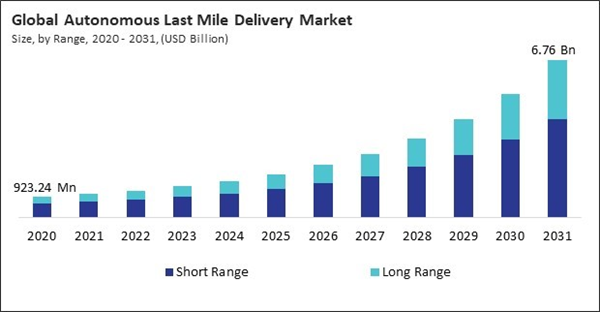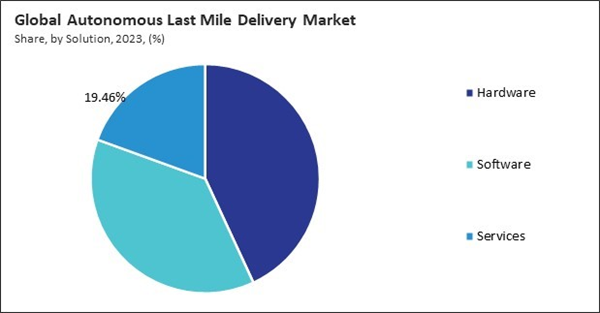The Global Autonomous Last Mile Delivery Market size is expected to reach $6.76 billion by 2031, rising at a market growth of 23.1% CAGR during the forecast period.
The North America segment recorded 43% revenue share in the market in 2023. The presence of major players such as Amazon, FedEx, UPS, and Walmart has significantly accelerated the deployment of autonomous ground bots, self-driving vans, and aerial drones for last-mile delivery. Favorable government policies, robust R&D initiatives, and the expansion of smart city infrastructure have further strengthened market growth.
The e-commerce boom, fueled by platforms like Amazon, Flipkart, Alibaba, and Walmart, has placed immense pressure on logistics networks to optimize delivery efficiency and reduce costs. According to the United Nations Conference on Trade and Development (UNCTAD), the global e-commerce industry was valued at $26.7 trillion in 2019, with online retail sales accounting for 19% of total retail sales, a significant jump from 16% in 2019. This surge in online shopping creates an urgent need for scalable and automated logistics solutions, particularly in last-mile delivery, which accounts for more than 50% of total shipping costs. Hence, as online retail expands, adopting AI-driven logistics solutions will ensure efficient, timely, and cost-effective last-mile deliveries, shaping the future of e-commerce logistics.
Additionally, Advancements in Artificial Intelligence (AI), Machine Learning (ML), and Robotics are revolutionizing autonomous last-mile delivery by enhancing efficiency, accuracy, and cost-effectiveness. AI-powered route optimization enables real-time adjustments based on traffic patterns, weather conditions, and road congestion, ensuring the most efficient delivery paths. Thus, these factors will aid in the expansion of the market.
However, Developing an advanced autonomous system requires substantial funding for research and development (R&D), software engineering, and hardware integration. Companies must invest in cutting-edge technologies like LiDAR, radar, high-definition cameras, GPS navigation, and AI-driven decision-making systems to ensure seamless and safe deliveries. Building a fleet of ADVs, whether autonomous drones, robots, or self-driving delivery vans, involves expensive manufacturing processes and stringent testing to comply with safety and regulatory standards. Hence, the heavy financial burden of developing, deploying, and maintaining autonomous delivery vehicles remains a key roadblock to market expansion.
The North America segment recorded 43% revenue share in the market in 2023. The presence of major players such as Amazon, FedEx, UPS, and Walmart has significantly accelerated the deployment of autonomous ground bots, self-driving vans, and aerial drones for last-mile delivery. Favorable government policies, robust R&D initiatives, and the expansion of smart city infrastructure have further strengthened market growth.
The e-commerce boom, fueled by platforms like Amazon, Flipkart, Alibaba, and Walmart, has placed immense pressure on logistics networks to optimize delivery efficiency and reduce costs. According to the United Nations Conference on Trade and Development (UNCTAD), the global e-commerce industry was valued at $26.7 trillion in 2019, with online retail sales accounting for 19% of total retail sales, a significant jump from 16% in 2019. This surge in online shopping creates an urgent need for scalable and automated logistics solutions, particularly in last-mile delivery, which accounts for more than 50% of total shipping costs. Hence, as online retail expands, adopting AI-driven logistics solutions will ensure efficient, timely, and cost-effective last-mile deliveries, shaping the future of e-commerce logistics.
Additionally, Advancements in Artificial Intelligence (AI), Machine Learning (ML), and Robotics are revolutionizing autonomous last-mile delivery by enhancing efficiency, accuracy, and cost-effectiveness. AI-powered route optimization enables real-time adjustments based on traffic patterns, weather conditions, and road congestion, ensuring the most efficient delivery paths. Thus, these factors will aid in the expansion of the market.
However, Developing an advanced autonomous system requires substantial funding for research and development (R&D), software engineering, and hardware integration. Companies must invest in cutting-edge technologies like LiDAR, radar, high-definition cameras, GPS navigation, and AI-driven decision-making systems to ensure seamless and safe deliveries. Building a fleet of ADVs, whether autonomous drones, robots, or self-driving delivery vans, involves expensive manufacturing processes and stringent testing to comply with safety and regulatory standards. Hence, the heavy financial burden of developing, deploying, and maintaining autonomous delivery vehicles remains a key roadblock to market expansion.
Driving and Restraining Factors
Drivers
- Increasing E-Commerce And Online Retail
- Rapid Advancements In AI And Robotics
- Expansion Of Smart Cities Across The Globe
Restraints
- High Initial Investment & Operational Costs
- Competition From Traditional Delivery Methods
Opportunities
- Rising Labor Costs And Shortages
- Growing Number Of Investments And Startups
Challenges
- Regulatory And Legal Challenges
- Inaccurate Object Detection And Limitations In Battery Life
Range Outlook
On the basis of range, the market is bifurcated into short range and long range. The long range segment recorded 34% revenue share in the market in 2023. The adoption of self-driving trucks, autonomous vans, and aerial delivery drones is increasing as businesses seek solutions to reduce operational costs, optimize supply chain efficiency, and overcome labor shortages. The growth of cross-regional e-commerce, healthcare logistics, and bulk delivery services has further accelerated the demand for long-range autonomous solutions.Solution Outlook
By solution, the market is divided into hardware, software, and services. The software wire bond segment garnered 37% revenue share in the market in 2023. The integration of machine learning algorithms, IoT-enabled tracking, and cloud-based automation platforms enhances the ability of autonomous vehicles to navigate complex environments efficiently. Additionally, 5G connectivity and cybersecurity advancements improve vehicle-to-vehicle (V2V) and vehicle-to-infrastructure (V2I) communication, ensuring seamless coordination between delivery fleets.Vehicle Type Outlook
Based on vehicle type, the market is classified into self driving trucks & vans, aerial delivery drones, and ground delivery bots. The aerial delivery drones segment procured 25% revenue share in the market in 2023. The ability of drones to bypass traffic congestion and reach remote or disaster-affected areas has made them a valuable asset for last-mile logistics. Improvements in battery life, AI-driven navigation, and real-time tracking technologies have enhanced their efficiency, while regulatory support in some regions has accelerated their deployment.Application Outlook
Based on application, the market is segmented into logistics, healthcare & pharmaceutical, food & beverage, retail, and others. The food & beverage segment acquired 26% revenue share in the market in 2023. The need for fast, contactless, and cost-effective delivery options has led to the rapid deployment of autonomous food delivery bots, AI-powered route optimization, and temperature-controlled transport solutions. Urban areas, university campuses, and residential communities are witnessing increased use of ground robots and drone-based food deliveries, enhancing consumer convenience and reducing reliance on human-operated logistics.Regional Outlook
Region-wise, the market is analyzed across North America, Europe, Asia Pacific, and LAMEA. The Europe segment witnessed 32% revenue share in the market in 2023. The Europe segment is driven by sustainability initiatives, regulatory support for autonomous mobility, and the growing demand for efficient urban logistics. European countries actively promote eco-friendly and autonomous delivery solutions to reduce carbon emissions and ease congestion in densely populated cities. Strong government backing for pilot projects, smart city integration, and AI-based fleet management systems has encouraged wider adoption of autonomous last-mile delivery vehicles.List of Key Companies Profiled
- United Parcel Service, Inc.
- Matternet
- Zipline
- Deutsche Post DHL Group
- Amazon.com, Inc.
- Starship Technologies, Inc.
- FedEx Corporation
- JD.com, Inc.
- Relay Robotics, Inc.
- Robomart, Inc.
Market Report Segmentation
By Range
- Short Range
- Long Range
By Solution
- Hardware
- Software
- Services
By Vehicle Type
- Ground Delivery Bots
- Self Driving Trucks & vans
- Aerial Delivery Drones
By Application
- Retail
- Food & Beverage
- Healthcare & Pharmaceutical
- Logistics
- Other Application
By Geography
- North America
- US
- Canada
- Mexico
- Rest of North America
- Europe
- Germany
- UK
- France
- Russia
- Spain
- Italy
- Rest of Europe
- Asia Pacific
- China
- Japan
- India
- South Korea
- Singapore
- Malaysia
- Rest of Asia Pacific
- LAMEA
- Brazil
- Argentina
- UAE
- Saudi Arabia
- South Africa
- Nigeria
- Rest of LAMEA
Table of Contents
Chapter 1. Market Scope & Methodology
Chapter 2. Market at a Glance
Chapter 3. Market Overview
Chapter 4. Global Autonomous Last Mile Delivery Market by Range
Chapter 5. Global Autonomous Last Mile Delivery Market by Solution
Chapter 6. Global Autonomous Last Mile Delivery Market by Vehicle Type
Chapter 7. Global Autonomous Last Mile Delivery Market by Application
Chapter 8. Global Autonomous Last Mile Delivery Market by Region
Chapter 9. Company Profiles
Companies Mentioned
- United Parcel Service, Inc.
- Matternet
- Zipline
- Deutsche Post DHL Group
- Amazon.com, Inc.
- Starship Technologies, Inc.
- FedEx Corporation
- JD.com, Inc.
- Relay Robotics, Inc.
- Robomart, Inc.
Methodology

LOADING...










